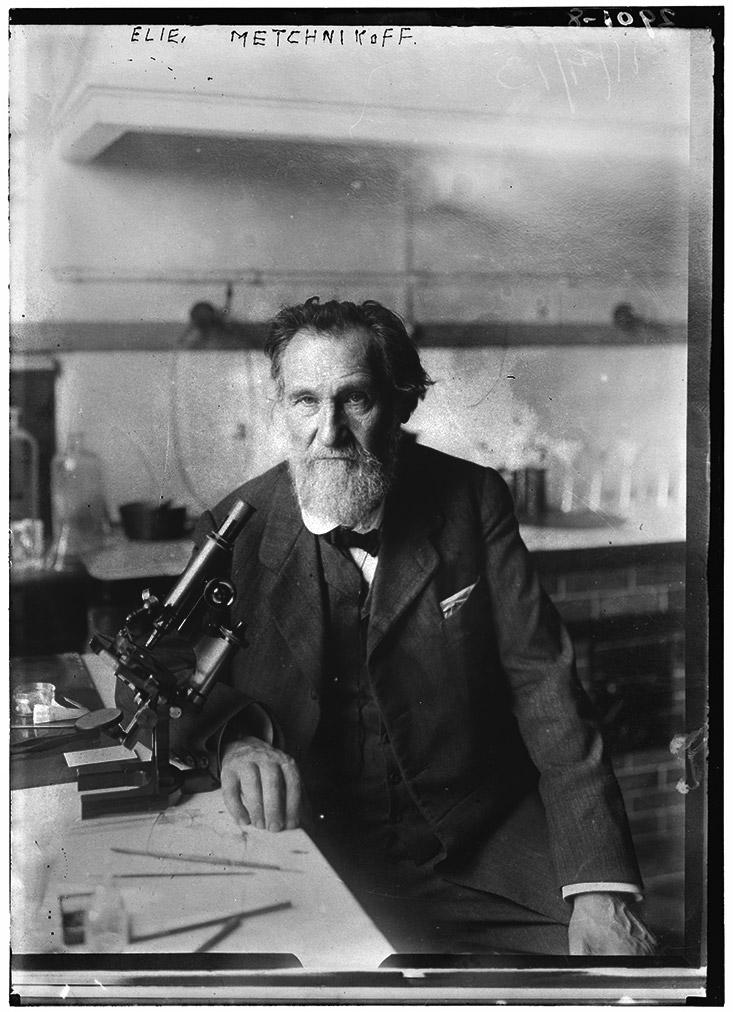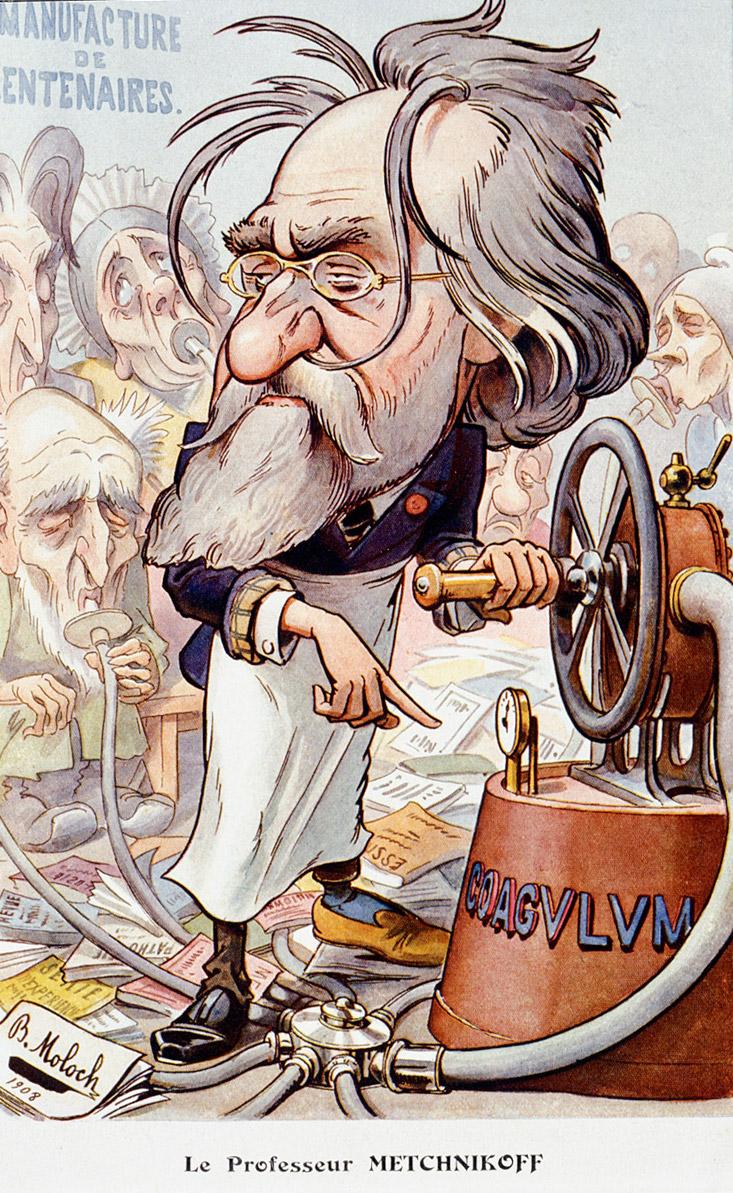What do Jamie Lee Curtis, gut bacteria, and a long forgotten Russian scientist have in common? Why, yogurt, of course. But wait, the answer is not that easy. Behind it stretches a tale that shows you can never predict cultural influence. It wends its way through the Pasteur Institute, the Nobel Prize, one of the hottest fields of scientific research today, the microbiome, and one of the trendiest avenues in nutrition, probiotics. It all began in the 19th century with a hyperactive kid in Russia who had a preternatural ability to connect dots where nobody saw dots at all.
When Ilya Metchnikoff was 8 and running around on his parents’ Panassovka estate in Little Russia, now Ukraine, he was making notes on the local flora like a junior botanist. He gave science lectures to his older brothers and local kids whose attendance he assured by paying them from his pocket money. Metchnikoff earned the nickname “Quicksilver” because he was in constant motion, always wanting to see, taste, and try everything, from studying how his father played card games to learning to sew and embroider with the maids. His wife later wrote in The Life of Ellie Metchnikoff that Metchnikoff asked the “queerest” questions, often exasperating his caretakers. “He could only be kept quiet when his curiosity was awakened by observation of some natural objects such as an insect or a butterfly.”
At 16, Metchnikoff borrowed a microscope from a university professor to study the lower organisms. Darwin’s On the Origin of Species shaped his comparative approach to science during his university years—he viewed all organisms, and physiological processes that took place in them, as interconnected and related.
The proper alteration of the intestinal flora could help battle diseases that had plagued humans for centuries.
That ability led him to the discovery of a particular cell and enabled him to link digestive processes in primitive creatures to the human body’s immune defenses. In lower organisms, which lack the abdominal cavity and intestines, digestion is accomplished by a particular type of cells—mobile mesodermal cells—that move around engulfing and dissolving food particles. While staring at mesodermal cells inside transparent starfish larvae, Metchnikoff, 37 at the time, had a thought. “It struck me that similar cells might serve in the defense of the organisms against intruders,” he wrote. He fetched a few rose thorns from the garden and stuck them into the larvae. If his hypothesis was correct, the larva’s body would recognize thorns as intruders and mesodermal cells would aggregate around the thorns in an attempt to gobble them up. As Metchnikoff expected, the mesodermal cells surrounded the thorns, proving his theory. He named his cells phagocytes, which in Greek means “devouring cells,” and likened them to an “army hurling itself upon the enemy.”
In 1888, Louis Pasteur invited Metchnikoff to join the Pasteur Institute in France, where Metchnikoff continued his research. He reasoned that if in simpler organisms mesodermal cells attack and digest invaders, then in humans, leucocytes—the white blood cells that make up pus—must attack and digest microbes. Therefore inflammation was merely a cellular response to an external agent, a body’s curative reaction. These ideas were completely contradictory to the established theory of inflammation, which stated leucocytes form a medium favorable to microbes’ growth and spread them around. But after researchers repeated Metchnikoff’s experiments, leucocytes were established as bacteria-fighting cells. In 1908, Metchnikoff won the Nobel Prize in Medicine for discovering phagocytic cells and their role in the human immune system.

After Metchnikoff discovered phagocytes, he plunged into researching human immunity, hopeful to find ways to extend lives. He was motivated by his own grim experiences with disease. When his first wife died from tuberculosis, despite his zealous efforts to save her, a grievous Metchnikoff took an overdose of opium, but lived. When his second wife, Olga, battled typhoid fever, he inoculated himself with a tick-borne disease to die with her—but they both lived. But having discovered the body’s natural defense system, Metchnikoff grew optimistic. “With the help of science,” he wrote, “man can correct the imperfections of his nature.”
As part of his immunity quest, Metchnikoff experimented on himself. During the 1892 cholera epidemic in France, he drank Cholera vibrio, a bacteria that causes the disease. Cholera vibrio had a peculiar modus operandi. Within the same community, some people contracted it while others seemed immune. An understanding of how such immunity develops could lead to a vaccine.
The cholera drink didn’t sicken Metchnikoff, so he let a volunteer from his lab repeat the test. When the first volunteer didn’t contract cholera either, Metchnikoff didn’t hesitate to accept an offer from a second one. To his horror, the young man fell ill and nearly died. When Metchnikoff took his experiments into the petri dish to find out what caused such a marked difference, he discovered that some microbes hindered the cholera growth while others stimulated it. He then proposed that the bacteria of the human intestinal flora played a part in disease prevention. And, he reasoned, if swallowing a pathogenic bacterial culture sickened you, then swallowing a beneficial one would make you healthier. Therefore, he decided, the proper alteration of the intestinal flora could help battle diseases that had plagued humans for centuries.
At the same time that Metchnikoff’s ideas about rebalancing the microbes in the gut were taking hold, a powerful current in medicine was running against them.
Intestinal flora was a hot topic in the late 19th century. One prominent theory viewed the human large intestine as a noxious reservoir of toxins, some of which resulted from bacteria breaking down food, the so-called “putrefaction” process. Medics hypothesized that the large intestine was a visceral leftover from the time when our ancestors had to run from predators and often didn’t have time to stop long enough to empty their bowels. As a result, humans kept the products of bacterial putrefaction in their intestines for too long and they became toxic. This intestinal putrefaction theory gained such prominence that British surgeon William Lane advocated the removal of the entire large intestine to remediate digestive disorders.
But Metchnikoff believed it was possible to achieve a microbial balance in the gut without surgery, and began a quest for beneficial bacteria. From food-preserving experiments at the Pasteur Institute, he knew that lactic acid can prevent milk from spoiling, turning it into a yogurt-like product. “As lactic fermentation serves so well to arrest putrefaction in general, why should it not be used for the same purpose within the digestive tube?” he questioned. After studying various suitable cultures, he zeroed in on Bulgarian bacilli, widely used in Eastern Europe to make yogurt. This boded well with his studies of European centenarians, who consumed a lot of sour milk products in their diet. He also suggested that the culture could be taken in the form of a pill. Unfortunately, Metchnikoff didn’t get to see the world benefiting from his insights. In 1916, he died from a heart attack. Minutes before his passing, he reminded his fellow Pasteur researcher Alexandre Salimbeni to “carefully” look into his intestines after his death.

As the 20th century unreeled, Metchnikoff’s ideas took hold. In Europe, doctors prescribed sour milk to treat intestinal maladies. Then in the 1910s, Isaac Carasso, a Balkan industrialist, learned that many children suffered from intestinal disorders. In 1919, inspired by Metchnikoff’s work, he started a yogurt company in Barcelona, Spain, and marketed his yogurt as medicine, sold in pharmacies. He named the company Danone, a Catalan variation on his son’s nickname, “Little Daniel.” After Carasso’s death, Daniel took over the company and expanded it into the United States, where it was branded Dannon.
At the same time that Metchnikoff’s ideas about rebalancing the microbes in the gut were taking hold, a powerful current in medicine was running against them: the development of antibiotics. The new medicines, notably penicillin, eradicated pathogens and bacterial infections far more quickly than sour milk products, which replenished the body’s acidophilus bacteria, helping balance the microbes in the gut. Scott Podolsky, the director of the Center for the History of Medicine at the Francis A. Countway Medical Library in Boston, says the transition was epitomized by Lederle Laboratories, which manufactured acidophilus products in the U.S., and switched to making antibiotics in the 1930s.
The truth is, yogurt does contain beneficial organisms that help replenish our own bacteria.
Yet just as antibiotics seemed to spell the end for Metchnikoff’s breakthrough, their overuse managed to revive it. “From the early 1950s, medical scientists became increasingly aware of the potentially negative impact of antibiotic administration in humans,” Podolsky says. Antibiotics had side effects. Antibiotic-resistant superbugs began to emerge. The autoimmune diseases surged. Studies in non-medical areas of microbiology also recognized that microbes played important roles in ecosystems such as oceans, forests, or soils, according to Lita Proctor, program coordinator at the Human Microbiome Project. Researchers were finding that microbes produced vitamins, nutrients, and growth factors, vital to ecosystems’ health. Eventually scientists began to view the human body as an ecosystem that depended on its microbes for proper nutrients.
In 2001, Joshua Lederberg, who won a Nobel Prize in Medicine in 1958 for his research in microbiology, coined the term microbiome. The term described the “ecological community of commensal, symbiotic, and pathogenic microorganisms” that live in and on our body. Today, microbiome studies, notably the Human Microbiome Project, funded by the National Institutes of Health, are underway, investigating our bodies’ microorganisms, and their relation to health and disease. Fortune recently called 2015 the year of microbiome. Meanwhile, the term “probiotics,” coined around the 1950s, is used to describe “organisms contributing beneficially to host microbial balance,” Podolsky says. Probiotics represent a growing research field and a multibillion-dollar industry. Yogurts, kefirs, and other fermented dairy products can be found in every supermarket.
And Jamie Lee Curtis? In one of those strange pop cultural phenomena where celebrities become the embodiment of a brand, the True Lies actress was long the face of the probiotic Activia yogurt, made by Dannon, the company inspired by Metchnikoff’s research. Yes, in 2010 Dannon had to pay a $35 million settlement in a class action suit for claiming Activia boosted the immune system, relieved irregularity, and warded off the flu, but the truth is, yogurt does contain beneficial organisms that help replenish our own bacteria. So while Curtis may no longer be the face of Activia, perhaps the next time you see her, or the yogurt at your corner store, you will think of Metchnikoff, the boy who loved butterflies, who saw the future of health and strove to improve it for us all.






























